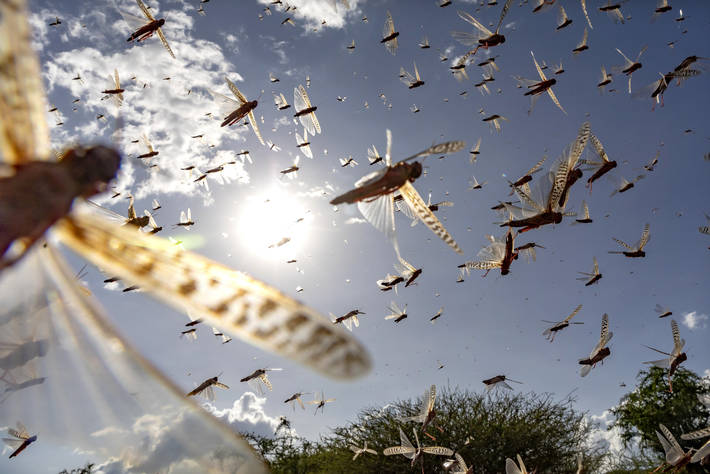COVID-19 now joins the “Annual One Health Locust Pandemic”. Annual because it’s been happening (nearly) every year for thousands of years. One Health because it involves both humans and animals (in this case insects).
The old testament of the Bible talks of the plague of locusts and it is remembered at Passover by those of the Jewish faith. And now, in this 21st century, much of East Africa is experiencing massive destruction of food crops from locust swarms of biblical proportions, the largest ever recorded in recent times.
As a result of unusually heavy rains, most likely caused by climate change, these huge swarms originated in the Arabian peninsula in 2018-2019. They have now hit Kenya, Ethiopia, and Somalia. And, they have entered Yemen and laid eggs along 560 miles of Iranian coastline.
Given the connection between “the locust” and human health, food insecurity, malnutrition, and economic loss to a very vulnerable population, that it should be such a tragedy is no surprise. Indeed, at the recently held Spring Meeting of the World Bank/IMF, it was acknowledged by global leaders and David Malpass, World Bank President, in his closing April 17, 2020 press conference, stated:
“As the pandemic (COVID-19) unfolds, disruptions in domestic food supply chains are emerging as a pressing issue in many countries. You all are aware of the locust crisis in East Africa, which is also hitting the food supply.”
So what can be done about it, either immediately or next year?
How to Address the Locust Pandemic
A leading entomologist at the International Institute of Tropical Agriculture (IITA) Dr. Peter Neuenschwander put the problem of doing anything significant this way:
“… at this time there is very little that can be done to help the affected farmers. But in the long term, concerned personnel should carefully monitor hopper bands on the ground in areas where locusts are known to lay their eggs. As soon as conditions for their development are conducive, bio-pesticides such as GreenMuscle should be applied. This will prevent the eggs from maturing into locusts.”
Neuenschwander goes on to say “[GreenMuscle]Production, started at IITA, was then picked up by a South African company. Even though FAO officially recommend GreenMuscle for control of locus hopper bands, production mostly ceased. It picked up again, when an NGO run by the Senegal president’s wife, started to produce GreenMuscle.”
At the local level, this story first appeared in Kenya’s Daily Nation on 1 February 2020 and was picked up again in several articles, including an interesting one reporting on a meeting where Kenyan farmers were informed by a team of local agronomists about how to address the locust threat with biological means. They were told to use pheromone (PAN) or fungi, known as “green muscle and green guard, which are eco-friendly and effective in early developmental stages (nymphs)”.
Since locusts cause most destruction when they are “swarming” in contrast to when they are in a solitary state, pheromones work by “confusing the swarming process and breaking it into solitary state”. This innovation is reported to have achieved success in Australia, South Africa, and Brazil.
The case for promoting GreenMuscle and new additions such as GreenSheild (in Australia) and NOVACRID (just trialed and now available for purchase) is that they kill locusts and other insects without affecting non-target insects, the environment, and human health.
So long as the locusts are not sprayed with toxic insecticides, they are a source of food for both humans and animals. So, their existence is far from all bad news.
A Call to Action for More Research and More Funding
There has, of course, been public institutions and privately funded research into how to contain or mitigate the damage done by locust swarms in Africa. But neither the extent of research, the supply chain capabilities, access, and costs of bio-effective pesticides by those most in need is sufficient. Certainly not rising to the level of vast sums and priority of other threats—particularly human, global, and not seasonal. Those rightly have attracted substantial resources.
But in the hundreds of billions now being found by multilateral and regional donors, and the private sector, there should be enough room for deeper research into locust surveillance, prevention/detection, and response.
The United Nations, through its Food and Agricultural Organization (FAO) has repeatedly called for funding, as Dr. Festus Akinnifesi, Executive Coordinator in charge of the FAO Resource Mobilization Division (PSR), explained in a recent article on Impakter. FAO scaled up its Desert Locust Appeal from $76 million to $153.2 million and so far $111.1 million have been pledged or received. As of 9 April, FAO reported it was still fighting the desert locust upsurge in East Africa and Yemen “despite COVID-19 constraints”. Since January 2020, more than 240,000 hectares have been treated and 740 personnel trained in affected countries. Good as it is, it’s far from enough.
Locust pandemics have been around for far too long, it’s time to take a longer-run perspective. Advances in many scientific disciplines could offer new pathways that were not available or explored in the past. With the world now intensely focused on COVID-19 and high-risk infectious diseases to human health, and with our rising awareness of the enormous disruptions such outbreaks can have on national, regional and global economies (and beyond to political stability), it is time to use this “awareness and call to action” window to put more research and invest more money into this recurring locust pandemic.
Doing so would be a critical One Health contribution to health, food security, economic security, and social cohesion for highly vulnerable populations, ones likely to soon face the wrath of COVID-19.
Editor’s Note: The opinions expressed here by Impakter.com columnists are their own, not those of Impakter.com — In the Featured Photo: Swarm of Desert Locusts in Isiolo County in Kenya Source: FAO/Sven Torfinn










